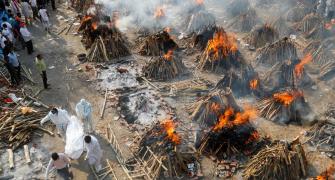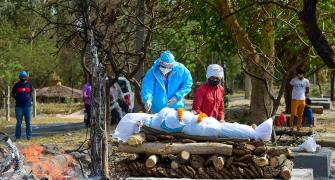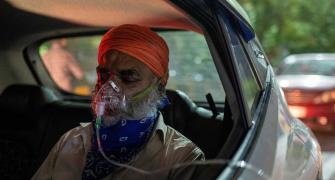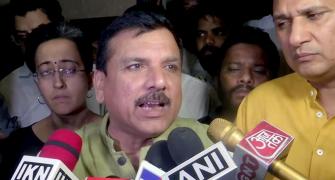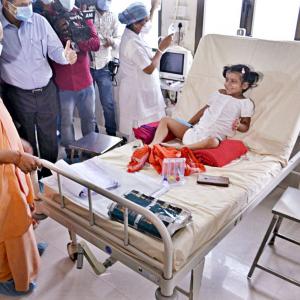Only the government has the capacity to collate all death data across all facilities and count corpses dumped in rivers.
And the government is patently not interested in finding out, observes Devangshu Datta.
Caution: Graphic content. Viewer discretion is advised.

A few weeks ago, pundits in Meerut went on strike.
They wanted danger money -- extra payment--for the last rites of COVID-19 victims.
Negotiations broke down on classification of corpses.
The priests said, as far as they were concerned, all corpses that weren't obviously unnatural deaths, should be classified as Covid.
The UP government's official count claimed very few Covid cases.
The rest had officially died of natural causes or some mysterious illness.
In April 2020, I pointed out lacunae in mortality data, which made it impossible to accurately classify fatalities into underlying causes.
Civil Registration Data says 80 per cent of estimated deaths -- around 6.4 million -- were officially registered in 2016-17, the latest year for which data is available.
It's estimated that about 8.2 million Indians actually died in 2016-2017, working out to about 22,500 daily deaths.
Extrapolating from there, the UN estimated India's death rate was 7.265 deaths per 1,000 persons in 2019 before COVID-19.
That is about 26,350 deaths per day. Of these, about 550 deaths were due to accident, or violence, adding up to 2 lakh unnatural deaths every year.
In 2017, medical certificates were issued for only 22 per cent of registered deaths.
In many cases, the cause was just an uninformative 'heart failure'.
About 80 per cent of Indians die without medical certification and where medical certificates do exist, it's hard to learn underlying causes.
You don't need a medical certificate to dispose of the body of someone who dies at home.
The cemetery issues a certificate. This may be presented to the municipality or panchayat for a death certificate.
Unless there's an inheritance involved, many people don't bother with the process.
In 2020, India had the capacity to dispose, with basic dignity, of about 30,000 corpses per day, in facilities spread across 750-odd districts.
In April 2020 I said, just one extra corpse per district per day could add up to 2 lakhs-3 lakhs of excess deaths a year without stressing capacity, or being visible.
There have been very visible excess deaths for over ten weeks.
What sort of toll has the 'second wave' and the government's incompetent response inflicted?
Reporters who have collated data from cemetery death registers, obituary notices, and counted corpses on riverbanks, reckon the official Covid toll is understated by a factor of about 5 (5x).
There have been waits of 12-30 hours at cemeteries, indicating deaths far exceeded 'disposal capacity' for want of a less delicate term.
The official toll ranges between 3,500-4500 daily deaths through this period.
Assuming 12 hours plus of wait time translates into 50 per cent excess of corpses over disposal capacity, about 45,000 people have died every day.
That is 18,000 excess deaths per day, which is 1.2 million excess deaths in the last ten weeks.
That does suggest under-counting of 4x or 5x.
Note too, there've been few deaths from accidents, or violent crimes.
This estimate surely has an error factor but it fits far better with the data samples than the official numbers.
The three month tally compares to disasters like Partition, the Bengal Famine and the 1920s flu pandemic.
There haven't been this many corpses dumped in the Ganga since the Kanpur massacre of 1857.
That led to the birth of an unusually large population of crocodiles and giant carp.
From 1921 onwards, Uttarakhand suffered the depredations of multiple man-eaters; Jim Corbett believed this was triggered by the availability of unburnt corpses after the flu pandemic.
It wouldn't be surprising if something similar occurred again.
What are the real numbers?
Only the government has the capacity to collate all death data across all facilities and count corpses dumped in rivers.
And the government is patently not interested in finding out.
The second wave has derailed hopes of economic recovery.
It could be another year of recession.
Vaccine production numbers and inoculation data make it clear India won't reach herd immunity for at least another year, or longer.
By then, there may be more dangerous mutations afoot, and the healthcare system also has to cope with threats like fungus infections.
The danse macabre will continue.


